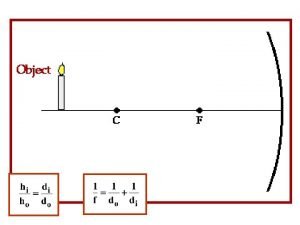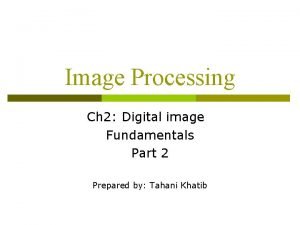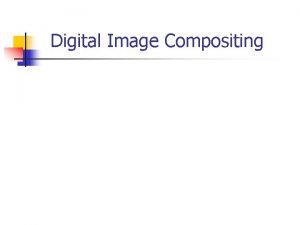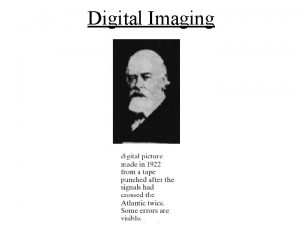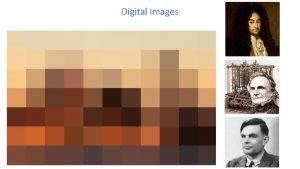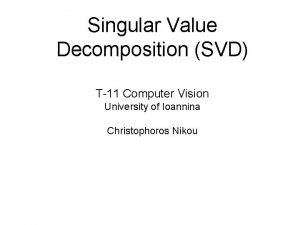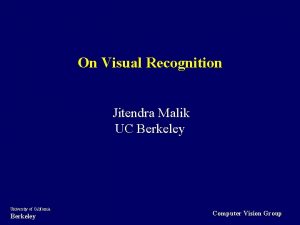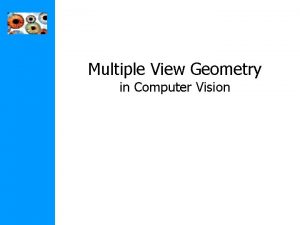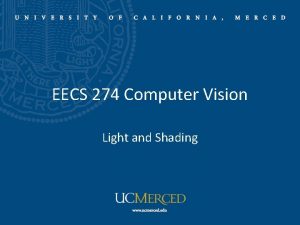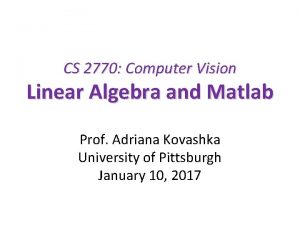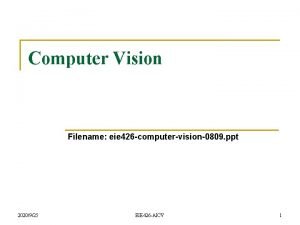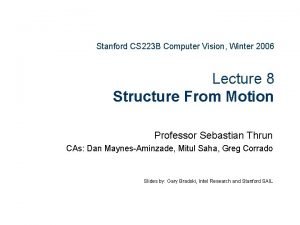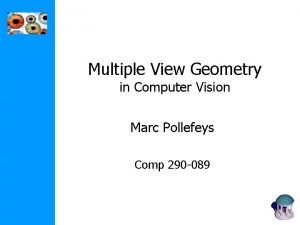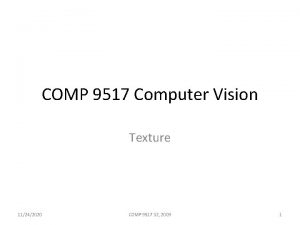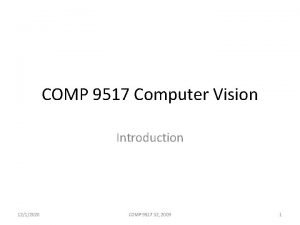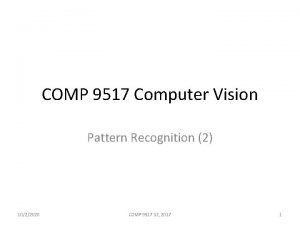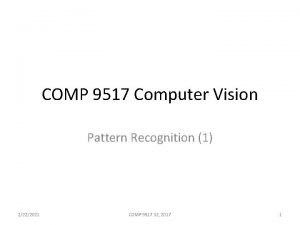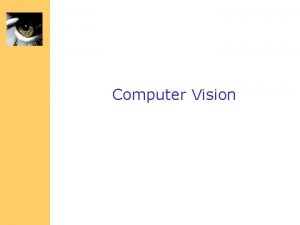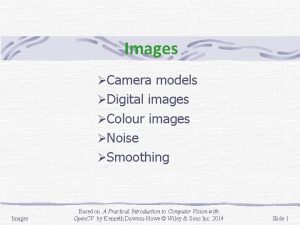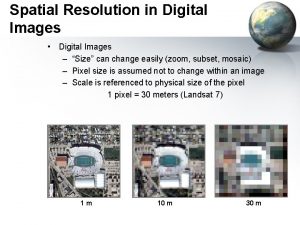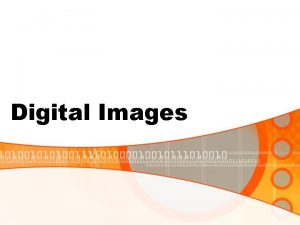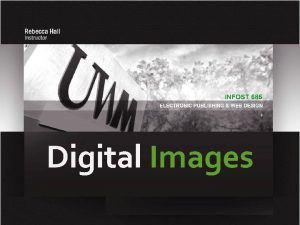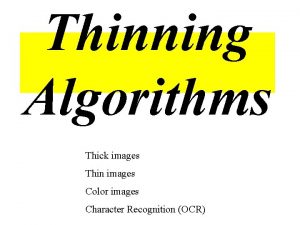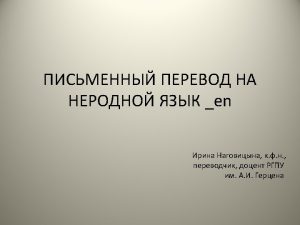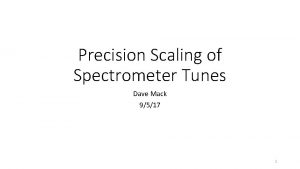COMP 9517 Computer Vision Digital Images 1022020 COMP



















![Type of images • Gray-scale image: a monochrome digital image I[r, c] with one Type of images • Gray-scale image: a monochrome digital image I[r, c] with one](https://slidetodoc.com/presentation_image/ba6999e76c7d06445e3117d402b6c084/image-20.jpg)






- Slides: 26

COMP 9517 Computer Vision Digital Images 10/2/2020 COMP 9517 S 2, 2009 1

Overview of Digital Images • Humans derive a great deal of information about the world through their visual sense – eyes. • Three components for construction of images: – A scene of objects – Illumination of the objects – Sensing the illumination 10/2/2020 COMP 9517 S 2, 2009 2

Overview of Digital Image • 2 D digital images is an array of intensity samples reflected from or transmitted through objects • Digital images contain fixed number of rows and columns of Pixels • Pixels (picture elements) are little tiles holding quantised values (0 -255) represent the brightness at the points of the image • Colour images have three values for each pixel (for example, RGB) 10/2/2020 COMP 9517 S 2, 2009 3

Overview of Digital Image 0 1 2 3 4 5 6 7 130 146 133 95 71 71 62 78 0 130 146 133 92 62 71 1 139 146 120 62 55 55 55 2 139 139 146 117 112 117 110 3 139 139 4 146 142 139 139 143 125 139 5 156 159 159 146 159 6 168 159 156 159 139 159 7 159 159 10/2/2020 COMP 9517 S 2, 2009 3 band for colour image 4

Digital Images - 2 D Projection of 3 D • 3 D world has color, texture, surfaces, volumes, light sources, objects, motion, connections, etc. • 2 D image is a projection of a scene from a specific viewpoint; many 3 D features are captured, but some missed. 10/2/2020 COMP 9517 S 2, 2009 5

Image Receives Reflections • Light reaches surfaces of objects • Surfaces reflect • Camera receives light energy 10/2/2020 COMP 9517 S 2, 2009 6

Radiation • Different types of electromagnetic radiation, such as X-ray, infra-red • Different wavelengths of radiation have different properties • Different devices to detect different radiation 10/2/2020 COMP 9517 S 2, 2009 7

Image Devices • CCD (charge-coupled device) cameras • Lens collects light rays • Cells (array of small fixed elements) convert light energy into electrical charge • Through frame grabber or IEEE 1394 to PC 10/2/2020 COMP 9517 S 2, 2009 8

Computer Vision System • Camera inputs to frame buffer • Program can interpret data • Program can add graphics • Program can add imagery 10/2/2020 COMP 9517 S 2, 2009 9

Image Formation • The geometry of image formation: the projection of each point of the 3 D scene through the centre of projection (or lens centre) onto the image plane • Pinhole Camera • Perspective projection • Affine projection 10/2/2020 COMP 9517 S 2, 2009 10

Perspective Projection • The apparent size of object depends on their distance: far object appear smaller • By similar triangles • Ignore third coordinate, and get 10/2/2020 COMP 9517 S 2, 2009 11

Affine Project • Scene depth is small relative to the average distance from the camera • Let magnification to be positive constant, since is negative, i. e. treat all points in scene being at constant distance from camera • Leads to weak perspective projection 10/2/2020 COMP 9517 S 2, 2009 12

Affine Project • The camera always remains at a roughly constant distance from the scene • Orthographic projection when normalise m to be -1 10/2/2020 COMP 9517 S 2, 2009 13

Picture function • A picture function is a mathematical representation f(x, y) of a picture as a function of two spatial variables x and y. – x and y: real values defining points of the picture – f(x, y): real value defining the intensity of point (x, y) 10/2/2020 COMP 9517 S 2, 2009 14

Picture Function and Digital Images • Analog image: a 2 D image F(x, y) has infinite precision in both spatial parameters x, y and intensity at each spatial point (x, y) • Digital image: a 2 D image I[r, c] by a discrete 2 D array of intensity samples with limited precision – Can be stored in a 2 D computer memory structure – 2 D array of discrete values. In C, char I[512] – Intensity as an 8 -bit number allows values of 0 -255 – 3 such values for colour image. 10/2/2020 COMP 9517 S 2, 2009 15

Sampling and Quantisation • Digitisation: convert analog image to digital image • Sampling: digitising the coordinate – spatial discretisation of a picture function f (x, y) – use a grid of sampling points, normally rectangular: image sampled at points x = j Δx, y = k Δy, j = 1. . . M, k = 1. . . N. – Δx, Δy called the sampling interval. 10/2/2020 COMP 9517 S 2, 2009 16

Spatial Resolution • Spatial Resolution: pixels per unit of length • Resolution decreases by one half • Human faces can be recognized at 64 x 64 pixels per face • Appropriate resolution is essential: – too little resolution, poor recognition – too much resolution, slow and wastes memory 10/2/2020 COMP 9517 S 2, 2009 17

Sampling and Quantisation • Quantisation: digitising the amplitude values – called intensity or gray level quantisation – Gray-level resolution: • usually has 16, 32, 64, . . , 128, 256 levels • number of levels should be high enough for human perception of shading details - human visual system requires about 100 levels for a realistic image. 10/2/2020 COMP 9517 S 2, 2009 18

Image Coordinate System • Raster oriented: down-leftward (a) • Cartesian coordinate: up-leftward (b, c) • Relationship btn pixel centre point to I[i, j] 10/2/2020 COMP 9517 S 2, 2009 19
![Type of images Grayscale image a monochrome digital image Ir c with one Type of images • Gray-scale image: a monochrome digital image I[r, c] with one](https://slidetodoc.com/presentation_image/ba6999e76c7d06445e3117d402b6c084/image-20.jpg)
Type of images • Gray-scale image: a monochrome digital image I[r, c] with one intensity value per pixel • Multispectral image: a 2 D image M[x, y] has a vector of values at each pixel, colour image (r, g, b) • Binary image: a digital image with all pixel values 0 or 1 • Labelled image: a digital image L[r, c] with pixel values as symbols denoting the decisions made for that pixel 10/2/2020 COMP 9517 S 2, 2009 20

Digital Image Format • Image file header: non image information for labelling and decoding data • Image data • Data Compression – Lossless: can be recovered exactly – Lossy: may lose quality 10/2/2020 COMP 9517 S 2, 2009 21

Common Image Format • Run-Coded Binary Image: an efficient coding scheme for binary or labelled images 10/2/2020 COMP 9517 S 2, 2009 22

Common Image Format • PGM(PBM/PGM, PPM): Portable gray map One of the simplest file formats 10/2/2020 COMP 9517 S 2, 2009 23

Common Image Format • Gif(GIF): Graphics Interchange Format, WWW, 8 bits – 256 colour levels, may be lossless • Tiff(TIFF/TIF): Tag Image File Format, 1 -24 bits, lossy or lossless • Jpeg(JFIF/JFI/JPG): Joint Photographic Experts Group, up to 24 bits, recent standard, independent of colour system, lossy or lossless • Post. Script(PDF/PDL/EPS): encoded by ASCII • Mpeg(MPG/MPEG-2): Motion Picture Expert Group, stream-oriented encoding of video 10/2/2020 COMP 9517 S 2, 2009 24

References • Driscoll, W. and Vaughan, W. , eds (1978), Handbook of Optics, Mc. Grtaw-Hill. • Boyle, W. and Smith, G. (1970), Charge coupled semiconductor devices, Bell Syst. Tech. J. 49, 587 -593. • Huang, T. S. (1965), PCM Picture Transmission. IEEE Spectrum, vol. 2, no. 12, pp. 57 -63. 10/2/2020 COMP 9517 S 2, 2009 25

Acknowledgement • Some material, including images and tables, were drawn from the textbook and Stockman’s online resources. 10/2/2020 COMP 9517 S 2, 2008 26
 Cs766
Cs766 Real vs virtual images
Real vs virtual images Do f
Do f Mail @ malaysia.images.search.yahoo.com
Mail @ malaysia.images.search.yahoo.com How to save images on google images
How to save images on google images Yahoo.com.yw
Yahoo.com.yw Zooming and shrinking in digital image processing
Zooming and shrinking in digital image processing Digital jewellery ring
Digital jewellery ring Sources of digital images
Sources of digital images Compositing digital images
Compositing digital images Digital imaging definition
Digital imaging definition Stelarc ear
Stelarc ear Image formation model in digital image processing ppt
Image formation model in digital image processing ppt 16-385 cmu
16-385 cmu Kalman filter computer vision
Kalman filter computer vision T11 computer
T11 computer Berkeley computer vision
Berkeley computer vision Multiple view geometry in computer vision
Multiple view geometry in computer vision Face detection viola jones
Face detection viola jones Radiometry in computer vision
Radiometry in computer vision Linear algebra for computer vision
Linear algebra for computer vision Computer vision
Computer vision Computer vision models learning and inference
Computer vision models learning and inference Computer vision ppt
Computer vision ppt Computer vision stanford
Computer vision stanford Multiple view geometry in computer vision
Multiple view geometry in computer vision Python azure cognitive services
Python azure cognitive services


